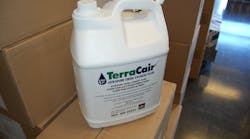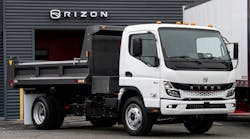Diesel exhaust fluid or DEF is a critical ingredient for making selective catalytic reduction (SCR) work. It's a clear fluid with a very slight yellowish tinge to it and smells faintly of ammonia; yet without it, trucks equipped with SCR systems won't be able to scrub their exhaust emissions — and thus won't be allowed to function.
Comprised of 67.5% water and 32.5% automotive grade urea, DEF is a key element in the SCR process. By spraying minute amounts of DEF into a truck's exhaust stream, ozone-causing oxides of nitrogen (NOx) are converted into harmless nitrogen gas (N2) and water vapor (H2O). In essence, DEF plays a critical role in making the air coming from a truck's tailpipe cleaner than the air going into its engine, says David McKenna, powertrain marketing manager for Mack Trucks.
More importantly, he adds, DEF and SCR help improve miles per gallon significantly over current levels. “It's all about fuel economy,” stresses McKenna. “In our 2010 testing so far, we're using less DEF … and we're seeing up to an 18% improvement in fuel economy over pre-2007 engines, and up to a 5% fuel economy improvement over our '07 package, depending on the duty cycle. That's what's important here.”
DEF: WHAT IS IT?
Before discussing how DEF works within the SCR system to not only reduce emissions but also reportedly improve fuel economy, it's good to know exactly what DEF is and isn't.
As noted above, DEF is made primarily from water mixed with “automotive-grade urea.” Urea is a compound of nitrogen that turns to ammonia when heated and is primarily used as fertilizer in agriculture. Though urea occurs naturally, it is commonly made from natural gas.
Urea is typically produced in two steps, using ammonia and carbon dioxide as basic raw materials in the process. The first step is an exothermic (heat releasing) reaction in which ammonia plus carbon dioxide creates ammonium carbamate. The second step is an endothermic (absorbing energy within heat) reaction in which ammonium carbamate is converted into water plus urea. According to Cummins Filtration, a division of the engine maker that produces diesel particulate filters (DPFs) and DEF, it's the ammonia (NH3) within urea that is the vital ingredient necessary to break apart NOx into N2 and H20.
DEF is classified as a “nonhazardous material” by the Environmental Protection Agency as the urea in the DEF mix is a naturally occurring substance, is nonflammable, and is biodegradable. However, it's neither safe for human consumption nor for prolonged exposure to the skin.
Cummins says DEF spills should be contained and absorbed with an inert, noncombustible absorbent material such as sand. Spills into a drain should be avoided. If DEF gets spilled into a drain, says Cummins, flush thoroughly with water. For significant quantities, contact local authorities for proper disposal procedures, the OEM stresses.
DEF is also corrosive to certain metals such as copper, brass and some grades of aluminum, according to Cummins, which is why DEF storage tanks are made from high density polyethelyne, a heavy durable plastic.
Cummins stresses the DEF that truckers purchase should display the certification of DIN standard 70700 or ISO standard 22241-1, and meet AUS-32 specifications to ensure the proper purity and concentration (32.5%) of urea. Furthermore, a voluntary certification program established by the American Petroleum Institute (API) will certify and monitor the DEF sold in truckstops, refueling locations, etc., to make sure it meets ISO specs.
Cummins adds that it and other engine OEMs will require that the DEF used in an SCR system meet all ISO 22241 specifications, as well as API certification requirements, to maintain their engine and SCR system warranties.
DEF: PERFORMANCE & DISTRIBUTION
So how does DEF behave in the real world? And, frankly, where will you be able to get it in the real world?
For starters, let's examine its behavioral characteristics in hot and cold temperatures. According to Mack's McKenna, DEF freezes at around 12 deg. F. Some truck makers using SCR are going to build heating elements into the plastic DEF storage tank onboard the vehicle to prevent this from happening — most notably Daimler Trucks North America on its Freightliner and Western Star brands. Others, like Mack and Volvo, plan to let DEF freeze — largely because very little DEF is needed when the engine is cold, McKenna stresses.
“A cold engine does not produce NOx,” he explains. “An SCR-equipped engine at cold start with a one-hour idle warmup is only going to need three tablespoons of DEF to handle the NOx levels being produced. More than enough will thaw in that time.”
At the upper end of the mercury, DEF remains stable at 85 to 90 deg. F; at around 122 deg. it begins to break down to a degree, reducing the efficiency of the SCR but only slightly, McKenna says. He stresses that DEF does not produce ammonia gas at high temperatures either. If anything, it would produce water vapor, since that is the main ingredient in the DEF solution.
Cummins recommends that DEF be stored between 10 and 90 deg. F, giving the fluid a shelf life greater than one year. The OEM recommends DEF be stored in a cool, dry, well-ventilated area, out of direct sunlight. While the optimum storage temperature is up to 77 deg F, temporary exposure to higher temperatures has little to no impact on the quality of DEF. If exposure to temperature spikes above 75 deg. is limited, Cummins says DEF can last as long as two years in storage.
The distribution of DEF will require truckers to rely on a mix of methods. Currently, DEF is available in 2.5- and 5-gal. jugs; 55-gal. drums; 275-gal. intermediate bulk containers; and 330-gal. plastic totes.
Several truckstop and refueling location chains such as Pilot, Flying J, Travel Centers of America (which includes Petro Stopping Centers) and Love's are committed to providing DEF dispensers right alongside their diesel fuel pumps and are in the process of installing 1,000 gal. DEF bulk filling stations.
Cummins notes that DEF dispensers at retail need three certifications — UL certified, weights/measures approved, and point of sale compliant — and that filling station equipment that meets these requirements is going to cost approximately $33,000 for starters.
The OEM stresses, however, that truckers will not need to fill up as frequently with DEF as they need to with diesel fuel. According to its research, DEF is typically consumed on a 50 to 1 ratio with diesel; so, for every 50 gal. of diesel fuel burned, a truck uses 1 gal. of DEF.
In terms of real-world calculations, Cummins points to this example: A heavy-duty truck averaging 120,000 mi. a year and getting 6 mpg consumes roughly 20,000 gal. of diesel annually. Based on that 50 to 1 ratio, 400 gal. of DEF will be needed for an SCR-equipped truck, and with most truck makers providing DEF tanks with 20 gal. or more of capacity, that translates into only about 20 fillups per year.
THE COST OF DEF
A big question in the minds of truck owners contemplating the purchase of SCR-equipped trucks is how much DEF will cost.
In Europe, where SCR is used extensively on diesel-powered commercial trucks and DEF is sold under the brand name AdBlue, the price varies depending on the quantity purchased, but it usually runs about half the gross cost of diesel fuel on a per liter basis.
In the U.S., however, DEF will most likely mirror the cost of diesel, anywhere from $2.20 to $2.50/gal. on average, again depending on what quantity is purchased, says Mack's McKenna. The key, however, is that far less DEF is consumed on an operating basis, while diesel fuel consumption is also cut, giving truck owners using SCR a net gain in fuel economy, he stresses.
“Let's say a fleet buys diesel for $2.42 a gallon and DEF for $2.20 a gallon,” McKenna says. “That will still save a truck owner $1,650 annually in fuel costs. Now, let's say diesel prices rise to $3.50 a gallon, and DEF climbs to $2.50 a gallon, that will save truckers $2,550 a year in fuel. It's all about trading in a lot of diesel consumption for a little bit of DEF.”



